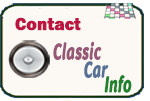Relative to the million plus new cars produced during the golden decades of the Fifties and Sixties, very few survived. After around a decade of being pushed to their limits under the testing UK and European winters, most of these cars were taken out of circulation.
Most were hauled off to the breakers yard with just a relative handful remaining stored in abandoned lock ups or under tarpaulins at the back of a field. An absolute handful were kept in a driveable condition- lovingly cared for by and gradually restored by devoted enthousiasts.
In the last twenty years or even more, an incredible surge in interest has grown up around classic cars and their restoration. While vehicles produced during the twentieth century have been improved dramtically, both in terms of appearance and technical capabilities, to many they lack the character of these vehicles, some of them produced more htna Seventy years ago.
 To drive one of these cars means standing out from the crowd, through owning a vehicle that is truly unique, with the owner's personality stamped all over it
To drive one of these cars means standing out from the crowd, through owning a vehicle that is truly unique, with the owner's personality stamped all over it
The goal of My Classic Car Blog is to provide those new to classic car restoration with an informative guide to help them plan their project, understand the stages involved, realise their limitations so they can avoid any pitfalls along the way.
 Pitfalls that, if not handled properly and quickly, could cause the restoration project to be held up, not stay within budget, and even end in disaster.
Pitfalls that, if not handled properly and quickly, could cause the restoration project to be held up, not stay within budget, and even end in disaster.
We invite classic car restorers to look upon My Classic Car Blog as a kind of roadmap which, if the advice given is followed closely, will lead the restorer to successfully complete their restoration project.
The major restoration procedures that need to be followed for UK and European Classic Car owners, but not necessarily in the order given are as follows:
*![]() : including choosing the ideal classic car, establishing a workshop, getting to know the vehicle, workshop health and safety, choosing tools and equipment,
: including choosing the ideal classic car, establishing a workshop, getting to know the vehicle, workshop health and safety, choosing tools and equipment,
*![]() : including the engine, gearbox, clutch, camshaft, carburettor, cooling system, cylinder head, driveshaft and exhaust system)
: including the engine, gearbox, clutch, camshaft, carburettor, cooling system, cylinder head, driveshaft and exhaust system)
*![]() including the axles, brakes, suspension, steering,
including the axles, brakes, suspension, steering,
*![]() including the alternator, battery, ignition coil, lighting, wiring, fuses, solenoids, starters, distributors and spark plugs.
including the alternator, battery, ignition coil, lighting, wiring, fuses, solenoids, starters, distributors and spark plugs.
*![]() including treating rust, fabricating metal, panel beating, welding body metal,
including treating rust, fabricating metal, panel beating, welding body metal,
*![]() including filling, masking, spraying paint,
including filling, masking, spraying paint,
*![]() including wood trim, instrument panel, interior lights , steering wheel, dashboard ,
including wood trim, instrument panel, interior lights , steering wheel, dashboard ,
*![]() including chrome trim, wood trim, mouldings, convertible tops, nameplates, number plates, emblems, windows, wire wheels,
including chrome trim, wood trim, mouldings, convertible tops, nameplates, number plates, emblems, windows, wire wheels,
*![]() including repalcing carpets, carpet cleaning,
including repalcing carpets, carpet cleaning,
*![]() including re-upholstery, fabric upholstery, vinyl upholstery, leather upholstery, armrests, door panels, headliners,
including re-upholstery, fabric upholstery, vinyl upholstery, leather upholstery, armrests, door panels, headliners,
 For the countless thousands that have completed a classic car restoration, for the many more that are currently working on one and especially for those considering restoring a classic in the future, My Classic Car Info will continue to provide history, tips, tricks, terminology and news on all aspects of the wonderful world of classic cars.
For the countless thousands that have completed a classic car restoration, for the many more that are currently working on one and especially for those considering restoring a classic in the future, My Classic Car Info will continue to provide history, tips, tricks, terminology and news on all aspects of the wonderful world of classic cars.
Sign up for a subscription for our weekly newsletter- today.
<< Pop Up 3 - Enter Your Content Here >>



